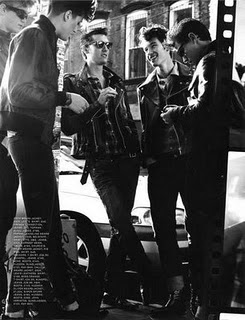
The Cockettes Photo Mary Ellen Mark
The Cockettes were a psychedelic "genderfuck" drag troupe founded by Hibiscus in the late 1960s in San Francisco. This florid and fluorescent LSD-fueled drag ensemble of glitter-and feather-bedecked hippies (women, gay men, and babies) in gender-bending drag performed legendary midnight musicals at the Palace Theater in North Beach. With titles like "Tinsel Tarts in a Hot Coma" and "Pearls over Shanghai", these all singing, all dancing extravaganzas featured elaborate costumes, rebellious sexuality, and exuberant chaos. Rodgers & Hammerstein gone terribly, terribly wrong: Busby Berkeley meets Dr. Seuss directed by Federico Fellini in drag.
The Cockettes first performance took place on New Years Eve, 31 December 1969, at the Palace Theatre in San Francisco's North Beach neighborhood and soon became a "must-see" for San Francisco's hip gay community, combining LSD-influenced dancing, set design, costumes and their anarchic versions of show tunes (or original tunes in the same vein). The chorus line quickly evolved into bigger, wilder, and more lavish productions, and the Cockettes' shows fast became not-to-be-missed events for the hippest of San Francisco's free spirits. The audiences were often as wild as the shows, generating tremendous energy. New shows were created every few weeks - "Paste on Paste", "Gone with the Showboat to Oklahoma", and "Tropical Heatwave/Hot Voodoo", were some of the early titles. The early shows were mostly non-narrative revues, with everybody making their own costumes, and creative spontaneity reigning supreme. But with "Pearls Over Shanghai" the Cockettes produced their first show with all original script, music and lyrics. Combining grand spectacle with the endearing awkwardness of a high school operetta production, The Cockettes thrilled the audiences as much with their unpredictability as with their triumphs.
In anticipation of the televised wedding of President Nixon's daughter Tricia, The Cockettes made a film called TRICIA'S WEDDING, featuring a transvestite Tricia, a drunken Mamie Eisenhower, a party crashing Lady Bird Johnson, and a drag Eartha Kitt spiking the punch with LSD, resulting in a mad orgy. The Cockettes also appeared in the films ELEVATOR GIRLS IN BONDAGE, and LUMINOUS PROCURESS.
Truman Capote and Rex Reed attended a San Francisco performance of "Tinsel Tarts in a Hot Coma", and Reed wrote a glowing review in his nationally syndicated column, calling it "a landmark in the history of new, liberated theater..." "The Cockettes are where it's at!" raved Capote. The Cockettes became national media darlings and were invited to perform what would turn out to be a tumultuous 3 week run in New York.
Reed's review had New York buzzing in anticipation, from upper east side society to the lower east side underground. Diana Vreeland and Oscar de la Renta greeted the Cockettes on arrival and Robert Rauschenberg threw them a party in his loft. The opening night audience included John Lennon, Gore Vidal, Angela Lansbury, and Anthony Perkins.
The Cockettes performed their final show in San Francisco in the summer of 1972, "Journey to the Center of Uranus". At this time Divine, star of films by noted filmmaker John Waters', joined the group, thus making her San Francisco debut. In that show Divine performed her song "The Crab at the Center of Uranus" while dressed as a lobster. John Waters has described the scene as " complete sexual anarchy, which is always a wonderful thing."
http://www.youtube.com/watch?v=WnZX9vVBxjI&feature=related
Other members of the Cockettes were Link (aka Luther Cupp), Gary Cherry, Rumi Missabu, Tahara (whose parents had been rodeo clowns), Goldie Glitters, "Johnny Cockette", Sweet Pam (aka Pam Tent), Martin Worman, Scrumbly Koldewyn (who wrote tunes to Link's or Martin's lyrics), Fayette, Daniel Ware, Dusty Dawn, Linden, Brent Jensen, Pristine Condition, Reggie (aka Anton Dunigan), Miss Harlow (who had been an original Plaster Caster) and Kreemah Ritz (originally known as Big Daryl) and Chris Kilo who produced a few of the early shows after the Angels/Cockette split. Many other people too numerous to mention performed in only one or two shows.
Among the more famous people of the Cockettes... Tomata duPlenty, an early member, who left the group and went on to sing in the seminal L.A. synthpunk band, the Screamers. Du Plenty went on to play a Cockettes-inspired lead role in the punk rock musical Population: 1. Also 70's disco diva Sylvester. In Cockette shows, Sylvester's incredible singing and rendition of Billie Holiday songs were always sure to get a standing ovation. After the demise of the Cockettes Sylvester became a well-known disco singer during the late 1970s. During the groups last year, John Waters screen diva, Divine became a member and performed in the final show of the Cockettes.
The Cockettes were the subject of a 2002 documentary, The Cockettes. The film debuted at the 2002 Sundance Film Festival, where it was nominated for the Grand Jury Prize. It went on to a limited theatrical release and to play the film festival circuit. At the premiere at San Francisco's Castro Theatre many of the surviving Cockettes attended in genderfuck drag.
^ Tent, Pam. Midnight at the Palace. 2004. pp. 110 - 112.
Tent, Pam (2004). Midnight at the Palace: My Life as a Fabulous Cockette. Los Angeles:Alyson Books. ISBN 1-55583-874-X
The Cockettes, 2002 documentary.















